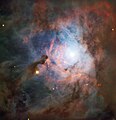Αρχείο:The Birth of the Hunter.jpg

Εικόνα σε υψηλότερη ανάλυση (1.705 × 1.767 εικονοστοιχεία, μέγεθος αρχείου: 708 KB, τύπος MIME: image/jpeg)
|
|
Αυτό το αρχείο και η περιγραφή του προέρχονται από το Wikimedia Commons. Οι πληροφορίες από την σελίδα περιγραφής του εκεί εμφανίζονται παρακάτω. |
Σύνοψη
| ΠεριγραφήThe Birth of the Hunter.jpg |
English: The constellation of Orion (The Hunter) is one of the most recognisable collections of stars in the night sky. We have noted Orion’s prominent stars for tens of thousands of years at least, and likely far longer. Chinese astronomers called it 参宿 or Shēn, literally “three stars”, for its three bright dots (which form the Hunter’s belt). The ancient Egyptians regarded it as the gods Sah and Sopdet, manifestations of Osiris and Isis, respectively, whereas Greek astronomers saw a brave hunter — the eponymous Orion — with his sword above his head, ready to strike.
Mythology aside, Orion is a fascinating patch of sky. This image, from ESO's Very Large Telescope, shows a reflection nebula nestled at the heart of the constellation — NGC 2023. Located close to the well-known Horsehead and Flame Nebulae, NGC 2023 lurks about 1500 light-years away from Earth, and is one of the largest reflection nebulae in the sky. Reflection nebulae are clouds of interstellar dust that reflect the light from nearby or internal sources, like fog around a car headlight. NGC 2023 is illuminated by a massive young star named HD 37903. The star is extremely hot — several times hotter than the Sun — and its bright blue-white light causes NGC 2023’s milky glow. Such nebulae are often the birthplaces of stars, and contain a clumpy distribution of gas that’s significantly denser than the surrounding medium. Under the influence of gravity, these clumps attract one another and merge, eventually creating a new star. In a few million years time, Orion's Belt may gain a new star! The image was taken with the VLT’s FORS (FOcal Reducer and Spectrograph) instrument as part of the ESO Cosmic Gems programme. This initiative produces images of interesting and visually attractive objects using ESO telescopes, for the purposes of education and outreach. The programme makes use of telescope time that cannot be used for science observations. All data collected may also be suitable for scientific purposes, and are made available to astronomers through ESO’s science archive.Italiano: La costellazione di Orione (The Hunter) è uno degli asterismi più riconoscibili nel cielo notturno. Gli astronomi cinesi lo chiamarono 参 宿 o Shēn, letteralmente " tre stelle ", per i suoi tre punti luminosi (che formano la cintura del cacciatore). Gli antichi egizi lo consideravano come gli dei Sah e Sopdet, rispettivamente le manifestazioni di Osiride e Iside, mentre gli astronomi greci videro un coraggioso cacciatore - l'omonimo Orione - con la spada sopra la testa, pronto a colpire.
Mitologia a parte, Orione è un affascinante angolo di cielo. Questa immagine, dal Very Large Telescope dell'ESO , mostra una nebulosa a riflessione incastonata nel cuore della costellazione. Situata vicino alle Nebulose Testa di Cavallo e Fiamma, NGC 2023 dista circa 1500 anni luce dalla Terra, ed è una delle più grandi nebulose a riflessione nel cielo |
| Ημερομηνία | |
| Πηγή | https://www.eso.org/public/images/potw1919a/ |
| Δημιουργός | ESO |
Αδειοδότηση
 |
This media was created by the European Southern Observatory (ESO).
Their website states: "Unless specifically noted, the images, videos, and music distributed on the public ESO website, along with the texts of press releases, announcements, pictures of the week, blog posts and captions, are licensed under a Creative Commons Attribution 4.0 International License, and may on a non-exclusive basis be reproduced without fee provided the credit is clear and visible." To the uploader: You must provide a link (URL) to the original file and the authorship information if available. |
Το αρχείο διανέμεται υπό την άδεια Creative Commons Αναφορά προέλευσης 4.0 Διεθνής
| |
Λεζάντες
Items portrayed in this file
απεικονίζει
13 Μαΐου 2019
Ιστορικό αρχείου
Κλικάρετε σε μια ημερομηνία/ώρα για να δείτε το αρχείο όπως εμφανιζόταν εκείνη τη στιγμή.
| Ώρα/Ημερομ. | Μικρογραφία | Διαστάσεις | Χρήστης | Σχόλια | |
|---|---|---|---|---|---|
| τελευταία | 15:22, 14 Φεβρουαρίου 2024 |  | 1.705 × 1.767 (708 KB) | C messier | full size |
| 08:39, 13 Μαΐου 2019 |  | 1.280 × 1.327 (195 KB) | Jmencisom | User created page with UploadWizard |
Συνδέσεις αρχείου
Τα παρακάτω λήμματα συνδέουν σε αυτό το αρχείο:
Καθολική χρήση αρχείου
Τα ακόλουθα άλλα wiki χρησιμοποιούν αυτό το αρχείο:
- Χρήση σε en.wikipedia.org
- Χρήση σε eu.wikipedia.org
- Χρήση σε vi.wikipedia.org
- Χρήση σε zh.wikipedia.org
Μεταδεδομένα
Αυτό το αρχείο περιέχει πρόσθετες πληροφορίες, πιθανόν από την ψηφιακή φωτογραφική μηχανή ή το scanner που χρησιμοποιήθηκε για την δημιουργία ή την ψηφιοποίησή της. Αν το αρχείο έχει τροποποιηθεί από την αρχική του κατάσταση, ορισμένες λεπτομέρειες πιθανόν να μην αντιστοιχούν πλήρως στην τροποποιημένη εικόνα.
| Αναφορά/Πάροχος | ESO |
|---|---|
| Πηγή | European Southern Observatory |
| Συνοπτικός τίτλος |
|
| Τίτλος εικόνας |
|
| Όροι χρήσης |
|
| Ημερομηνία και ώρα της παραγωγής ψηφιακών δεδομένων | 06:00, 13 Μαΐου 2019 |
| Λογισμικό που χρησιμοποιήθηκε | Adobe Photoshop CC 2018 (Windows) |
| Ημερομηνία και ώρα τελευταίας επεξεργασίας αρχείου | 22:34, 10 Ιανουαρίου 2019 |
| Ημερομηνία και ώρα της μετατροπής σε ψηφιακή μορφή | 12:20, 1 Μαΐου 2018 |
| Η ημερομηνία μετα-δεδομένων τροποποιήθηκε τελευταία | 23:34, 10 Ιανουαρίου 2019 |
| Μοναδικό αναγνωριστικό του αρχικού εγγράφου | xmp.did:2f00b251-73db-dd48-a2f8-badd7e262d4f |
| Λέξεις κλειδιά | NGC 2023 |
| Στοιχεία επικοινωνίας |
Karl-Schwarzschild-Strasse 2 Garching bei München, None, D-85748 Germany |
| Έκδοση IIM | 4 |
